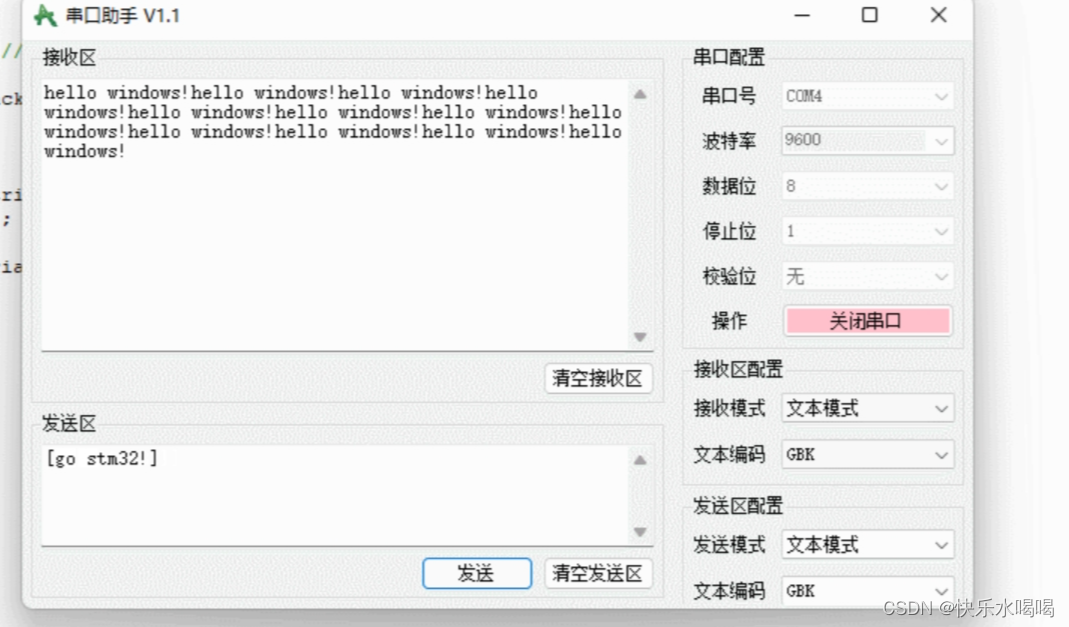实验一
用stm32F103核心板的GPIOA端一管脚接一个LED,GPIOB端口一引脚接一个开关(用杜邦线模拟代替)。采用中断模式编程,当开关接高电平时,LED亮灯;接低电平时,LED灭灯。如果完成后,尝试在main函数while循环中加入一个串口每隔1s 发送一次字符的代码片段,观察按键中断对串口发送是否会带来干扰或延迟。
main代码如下
#include "stm32f10x.h" // Device header
#include "Delay.h"
#include "Serial.h"
void CountSensor_Init(void){//配置中断
/*开启APB2的时钟*/
RCC_APB2PeriphClockCmd(RCC_APB2Periph_GPIOB, ENABLE);//开启APB2的外设,GPIOB是APB2的外设
RCC_APB2PeriphClockCmd(RCC_APB2Periph_AFIO, ENABLE);//开启AFIO的外设,AFIO是APB2的外设
//GPIOB
GPIO_InitTypeDef GIPO_InitStruct;//结构体配置GPIO
GIPO_InitStruct.GPIO_Mode = GPIO_Mode_IPU;//上拉输入模式input、out
GIPO_InitStruct.GPIO_Pin = GPIO_Pin_14;//开启14号引脚
GIPO_InitStruct.GPIO_Speed = GPIO_Speed_50MHz;
GPIO_Init(GPIOB, &GIPO_InitStruct);
//AFIO外外部引脚选择
EXTI_InitTypeDef EXTI_Int_Struct;//结构体Exti
GPIO_EXTILineConfig(GPIO_PortSourceGPIOB, GPIO_PinSource14);//PB14连接
EXTI_Int_Struct.EXTI_Line = EXTI_Line14;
EXTI_Int_Struct.EXTI_LineCmd = ENABLE;//开启
EXTI_Int_Struct.EXTI_Mode = EXTI_Mode_Interrupt;//中断模式
EXTI_Int_Struct.EXTI_Trigger = EXTI_Trigger_Falling;//下降沿触发
EXTI_Init(&EXTI_Int_Struct);
NVIC_InitTypeDef NVIC_IniyStruct;
NVIC_PriorityGroupConfig(NVIC_PriorityGroup_2);//响应等级
NVIC_IniyStruct.NVIC_IRQChannel = EXTI15_10_IRQn;
NVIC_IniyStruct.NVIC_IRQChannelCmd = ENABLE;
NVIC_IniyStruct.NVIC_IRQChannelPreemptionPriority = 1;
NVIC_IniyStruct.NVIC_IRQChannelSubPriority = 1;
NVIC_Init(&NVIC_IniyStruct);
}
//GPIOA初始化
void GPIOA_INIT(void){
GPIO_InitTypeDef GPIO_InitStructure;//定义变量GPIOA结构体
GPIO_InitStructure.GPIO_Mode = GPIO_Mode_Out_PP;
GPIO_InitStructure.GPIO_Pin = GPIO_Pin_0;
GPIO_InitStructure.GPIO_Speed = GPIO_Speed_50MHz;
GPIO_Init(GPIOA, &GPIO_InitStructure);//
GPIO_SetBits(GPIOA, GPIO_Pin_0);
}
int count = 0;
void LED1_Turn(void){
if (GPIO_ReadOutputDataBit(GPIOA, GPIO_Pin_0) == 0)
{
GPIO_SetBits(GPIOA, GPIO_Pin_0);
}
else
{
GPIO_ResetBits(GPIOA, GPIO_Pin_0);
}
}
int a=1;
void EXTI15_10_IRQHandler(void){
if(EXTI_GetITStatus(EXTI_Line14) == SET){
EXTI_ClearITPendingBit(EXTI_Line14);
if(a==1)
{
a=0;
}
}
}
int main(void){
CountSensor_Init();//初始化中断
RCC_APB2PeriphClockCmd(RCC_APB2Periph_GPIOA, ENABLE);//开启PA端口时钟
GPIOA_INIT();//初始化GPIOA代码
Serial_Init();
Serial_SendString("Init success!\t");
while(1){
Serial_SendString("a\t");
if(a==0)
{LED1_Turn();
a=1;
}
Delay_ms(1000);
}
}serail代码如下
#include "stm32f10x.h" // Device header
#include <stdio.h>
#include <stdarg.h>
void Serial_Init(void)
{
RCC_APB2PeriphClockCmd(RCC_APB2Periph_USART1, ENABLE);
RCC_APB2PeriphClockCmd(RCC_APB2Periph_GPIOA, ENABLE);
GPIO_InitTypeDef GPIO_InitStructure;
GPIO_InitStructure.GPIO_Mode = GPIO_Mode_AF_PP;
GPIO_InitStructure.GPIO_Pin = GPIO_Pin_9;
GPIO_InitStructure.GPIO_Speed = GPIO_Speed_50MHz;
GPIO_Init(GPIOA, &GPIO_InitStructure);//单片机输出口初始化
GPIO_InitStructure.GPIO_Mode = GPIO_Mode_IPU;
GPIO_InitStructure.GPIO_Pin = GPIO_Pin_10;
GPIO_InitStructure.GPIO_Speed = GPIO_Speed_50MHz;
GPIO_Init(GPIOA, &GPIO_InitStructure);//单片机输入口初始化
USART_InitTypeDef USART_InitStructure;
USART_InitStructure.USART_BaudRate = 9600;
USART_InitStructure.USART_HardwareFlowControl = USART_HardwareFlowControl_None;
USART_InitStructure.USART_Mode = USART_Mode_Tx | USART_Mode_Rx;
USART_InitStructure.USART_Parity = USART_Parity_No;
USART_InitStructure.USART_StopBits = USART_StopBits_1;
USART_InitStructure.USART_WordLength = USART_WordLength_8b;
USART_Init(USART1, &USART_InitStructure);
USART_Cmd(USART1, ENABLE);
}
void Serial_SendByte(uint8_t Byte)
{
USART_SendData(USART1, Byte);
while (USART_GetFlagStatus(USART1, USART_FLAG_TXE) == RESET);
}
void Serial_SendArray(uint8_t *Array, uint16_t Length)
{
uint16_t i;
for (i = 0; i < Length; i ++)
{
Serial_SendByte(Array[i]);
}
}
void Serial_SendString(char *String)
{
uint8_t i;
for (i = 0; String[i] != '\0'; i ++)
{
Serial_SendByte(String[i]);
}
}实验二
(1)当stm32接收到1个字符“s”时,停止持续发送“hello windows!”; 当接收到1个字符“t”时,持续发送“hello windows!”(提示:采用一个全局标量做信号灯);
(2)当stm32接收到字符“stop stm32!”时,停止持续发送“hello windows!”; 当接收到字符“go stm32!”时,持续发送“hello windows!”(提示:要将接收到的连续字符保存到一个字符数组里,进行判别匹配。写一个接收字符串的函数
(1)
代码
#include "stm32f10x.h"
#include <stdio.h>
volatile uint8_t continueSending = 1; // 全局变量作为信号灯,控制是否持续发送
void USART_Config(void) {
// 初始化串口通信,设置波特率等参数
USART_InitTypeDef USART_InitStructure;
GPIO_InitTypeDef GPIO_InitStructure;
RCC_APB2PeriphClockCmd(RCC_APB2Periph_GPIOA | RCC_APB2Periph_USART1, ENABLE);
// 配置USART1的TX引脚
GPIO_InitStructure.GPIO_Pin = GPIO_Pin_9;
GPIO_InitStructure.GPIO_Mode = GPIO_Mode_AF_PP;
GPIO_InitStructure.GPIO_Speed = GPIO_Speed_50MHz;
GPIO_Init(GPIOA, &GPIO_InitStructure);
// 配置USART1的RX引脚
GPIO_InitStructure.GPIO_Pin = GPIO_Pin_10;
GPIO_InitStructure.GPIO_Mode = GPIO_Mode_IN_FLOATING;
GPIO_Init(GPIOA, &GPIO_InitStructure);
USART_InitStructure.USART_BaudRate = 9600;
USART_InitStructure.USART_WordLength = USART_WordLength_8b;
USART_InitStructure.USART_StopBits = USART_StopBits_1;
USART_InitStructure.USART_Parity = USART_Parity_No;
USART_InitStructure.USART_Mode = USART_Mode_Rx | USART_Mode_Tx;
USART_InitStructure.USART_HardwareFlowControl = USART_HardwareFlowControl_None;
USART_Init(USART1, &USART_InitStructure);
USART_ITConfig(USART1, USART_IT_RXNE, ENABLE); // 使能串口接收中断
NVIC_EnableIRQ(USART1_IRQn); // 使能串口中断
USART_Cmd(USART1, ENABLE);
}
void USART1_IRQHandler(void) {
if (USART_GetITStatus(USART1, USART_IT_RXNE) != RESET) {
char receivedChar = USART_ReceiveData(USART1);
if (receivedChar == 's') {
continueSending = 0; // 收到字符's',停止发送
} else if (receivedChar == 't') {
continueSending = 1; // 收到字符't',持续发送
}
USART_ClearITPendingBit(USART1, USART_IT_RXNE);
}
}
void sendHelloWindows(void) {
char helloMsg[] = "hello windows!\r\n";
uint8_t i = 0;
while (helloMsg[i] != '\0') {
USART_SendData(USART1, helloMsg[i]);
while (USART_GetFlagStatus(USART1, USART_FLAG_TXE) == RESET);
i++;
}
}
int main(void) {
USART_Config();
while (1) {
if (continueSending) {
sendHelloWindows();
}
}
}
如图

(2)
代码如下
#include "stm32f10x.h"
#include <stdio.h>
#include <string.h>
#define MAX_RX_BUFFER_SIZE 50
volatile uint8_t continueSending = 1; // 全局变量作为信号灯,控制是否持续发送
char rxBuffer[MAX_RX_BUFFER_SIZE];
uint8_t rxIndex = 0;
void USART_Config(void) {
// 初始化串口通信,设置波特率等参数
USART_InitTypeDef USART_InitStructure;
GPIO_InitTypeDef GPIO_InitStructure;
RCC_APB2PeriphClockCmd(RCC_APB2Periph_GPIOA | RCC_APB2Periph_USART1, ENABLE);
// 配置USART1的TX引脚
GPIO_InitStructure.GPIO_Pin = GPIO_Pin_9;
GPIO_InitStructure.GPIO_Mode = GPIO_Mode_AF_PP;
GPIO_InitStructure.GPIO_Speed = GPIO_Speed_50MHz;
GPIO_Init(GPIOA, &GPIO_InitStructure);
// 配置USART1的RX引脚
GPIO_InitStructure.GPIO_Pin = GPIO_Pin_10;
GPIO_InitStructure.GPIO_Mode = GPIO_Mode_IN_FLOATING;
GPIO_Init(GPIOA, &GPIO_InitStructure);
USART_InitStructure.USART_BaudRate = 9600;
USART_InitStructure.USART_WordLength = USART_WordLength_8b;
USART_InitStructure.USART_StopBits = USART_StopBits_1;
USART_InitStructure.USART_Parity = USART_Parity_No;
USART_InitStructure.USART_Mode = USART_Mode_Rx | USART_Mode_Tx;
USART_InitStructure.USART_HardwareFlowControl = USART_HardwareFlowControl_None;
USART_Init(USART1, &USART_InitStructure);
USART_ITConfig(USART1, USART_IT_RXNE, ENABLE); // 使能串口接收中断
NVIC_EnableIRQ(USART1_IRQn); // 使能串口中断
USART_Cmd(USART1, ENABLE);
}
void USART1_IRQHandler(void) {
if (USART_GetITStatus(USART1, USART_IT_RXNE) != RESET) {
char receivedChar = USART_ReceiveData(USART1);
rxBuffer[rxIndex++] = receivedChar; // 将接收到的字符保存到缓冲区
if (rxIndex >= strlen("stop stm32!")) {
if (memcmp(rxBuffer, "stop stm32!", strlen("stop stm32!")) == 0) {
continueSending = 0; // 收到"stop stm32!",停止发送
} else if (memcmp(rxBuffer, "go stm32!", strlen("go stm32!")) == 0) {
continueSending = 1; // 收到"go stm32!",持续发送
}
rxIndex = 0; // 重置缓冲区索引
}
USART_ClearITPendingBit(USART1, USART_IT_RXNE);
}
}
void sendHelloWindows(void) {
char helloMsg[] = "hello windows!\r\n";
uint8_t i = 0;
while (helloMsg[i] != '\0') {
USART_SendData(USART1, helloMsg[i]);
while (USART_GetFlagStatus(USART1, USART_FLAG_TXE) == RESET);
i++;
}
}
int main(void) {
USART_Config();
while (1) {
if (continueSending) {
sendHelloWindows();
}
}
}如图

总结
在这次的实验帮助我们更好地理解和学习stm32,如有不足请多多指点





















 5941
5941

 被折叠的 条评论
为什么被折叠?
被折叠的 条评论
为什么被折叠?








